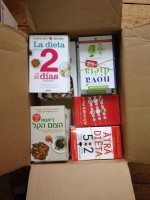Hello all! I’ve just finished reading The Fast Diet book and feel ready to get going (although starting on Monday, obvs… you can’t really start 5:2 at the weekend, plus it’s a foodie one with an 11-course taster dinner tomorrow and chocolate afternoon tea on Sunday, oops!).
I’m a creature of habit and feel the easiest way of me coping with this “diet” is to keep my daily food routine as near normal as possible on the fast days. As it it, I always have a healthy cereal-based breakfast (Weetabix and muesli with milk, topped with fruit), a pre-prepared homemade salad/hot meal for lunch that I take to work me (same thing Mon-Fri, changing the meal each week), and 2 poached eggs on a slice of Vogel for dinner (post-gym, which I do 4-5 times a week after work).
I’m thinking on my fast days of having 50g wholewheat porridge oats made with water + 80g berries (224 cals), no lunch, an apple pre-gym (47 cal) then my usual dinner (223 cals). For snacks, if necessary, I’ll go for Hartley’s jelly (4 cal).
I’m hoping this will be sustainable and I won’t feel too faint for my gym sessions after work. I don’t get home until 8.30pm most nights so my fasting hours will be 7am-8.30pm (eek!). Is this doable?
I reckon I’ll be downing a lot of black coffee, herbal teas and water throughout the day to keep the hunger pangs / boredom at bay. Hoping I can do it… roll on Monday!



2:09 pm
4 Aug 17